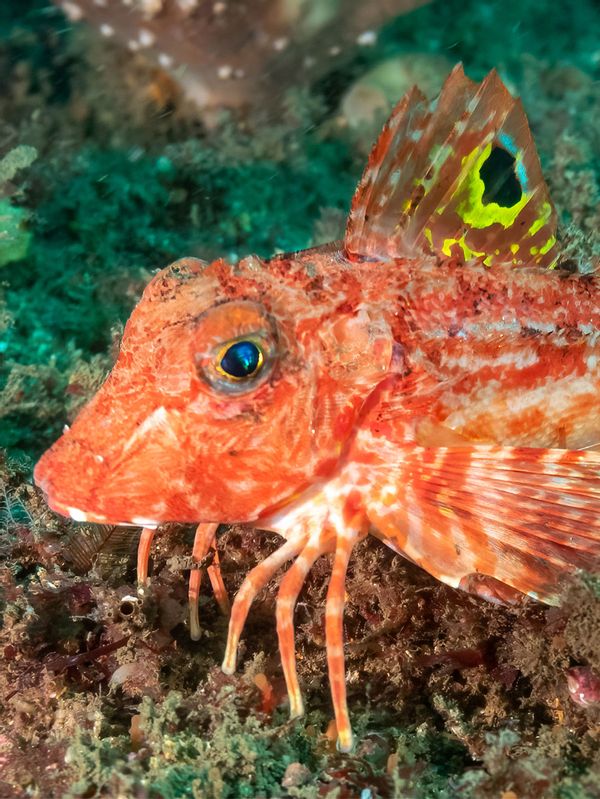
With a catfish-shaped body and face, sea robins come in a wide range of colors: Red-brown and orange to subtler hues of silver and gray. Yet sea robins are most notable for their distinctively large, fan-shaped dorsal fins and for their six leg-like appendages.
You read that correctly: A sea robin is a fish that effectively has legs. And thanks to two recent studies in the journal Current Biology — one about its sensory organs in its feet, the other about its genetic evolution — we now understand that these "legs" (really extensions of the pectoral fins) do more than just walk. They are full-fledged multi sensory organs.
Among other things, the scientists learn that sea robin legs are sensitive to mechanical and chemical stimuli. Even when burying capsules that contained only a single chemical, the sea robins could quickly find them. This was the case for a known species of sea robin that the scientists began studying, the Prionotus carolinus which dig to find buried prey with those super-sensitive legs. The scientists also discovered a new species of sea robin, the Prionotus evolans, which has legs with different abilities.

These are the various types of special cells that help the sea robin "taste" and otherwise detect the various chemicals in the sediment as it searches for food. The research team was assisted by scientists Amy Herbert and David Kingsley from Stanford University, who figured out "how these fish develop leg-like appendages from fins using ancestral limb genes and how the legs were then specialized in certain species to sense and uncover buried prey," Bellono said.
“We were not planning to study sea robins at all but happened to come across them on a trip to the Marine Biological Laboratory (in Woods Hole, Massachusetts) for squid," Bellono added. "Scott Bennett from the Marine Resource Center has worked with me since I studied electroreception in sharks as a postdoc and knows I appreciate weird creatures, so he showed us sea robins, or 'walking' fish with legs as he called them. He told us the stories about how other fish follow them around because they are so good at sensing and uncovering buried prey on the seafloor."
The group was especially pleased to learn that sea robins were so effective at covering up filtered mussel extract, even down to single amino acids. Amino acids are smaller even than individual strands of DNA.
"We were initially amazed at how different all sea robins are compared to other fish (presence of legs and ability to walk)," Kingsley said in a statement. "During the course of the collaborative studies with Nick’s lab, we were surprised to find how much sea robins species also differed from each other in sensory structures and behavior."
Naturally, the next question for biologists is to understand why these fish species diverge so sharply. The most logical explanation is that it has to do with adapting to their environment. That's where the second paper comes into play: By exploring the function of a gene known as tbx3a, Bellono and his colleagues figured out how a fish grows a new organ that functions both as a leg and a tongue.
"There are a couple hypotheses regarding the advantages of these evolutionary innovations in the bottom dwelling sea robin," Herbert said in a statement. "One is that using the legs to uncover buried prey opens up a new ecological niche for certain sea robin species. Another is that walking rather than swimming in some environments may be more energy efficient for sea robins."
Postdoctoral student Corey Allard, who was also instrumental to the research for this paper, plans on helping in those future endeavors.
"Moving forward, Corey and Amy plan to dissect the mechanisms by which sea robins develop sensory legs for understanding where limbs come and how they specialize for various forms of sensation," Bellono said. "I expect these studies will continue to teach us about the evolution of novel traits."
As Kinglsey added, "This research had identified some of the key players involved in developing legs and taste in sea robins. We still have to find what exactly has happened at the DNA level to redeploy ancient genes into new functions. Amy Herbert and Corey Allard are about to start their own labs at the University of Chicago and at Harvard. They will have a ton of cool problems to work in sea robins and other organisms that can now be studied using these new tools in genetics, genomicsand physiology."
As Bellono concluded, "To me, this is a great story of our scientific philosophy of being curious, opportunistic and open-minded to new biology, even if unexpected!”







